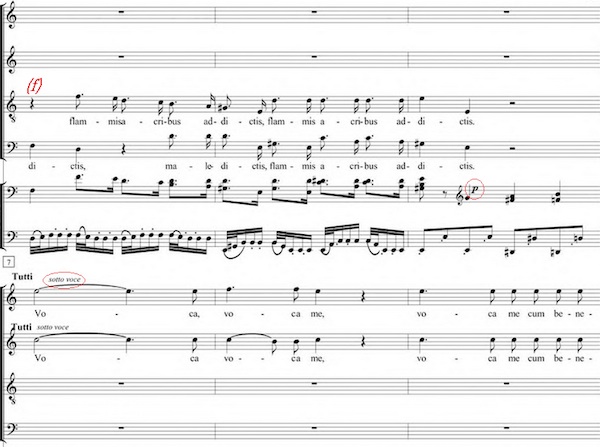Sometimes the whole is greater than the sum of its parts, and that can certainly be true with a choir. If you recorded every member of a choir separately and played the recordings simultaneously, it would not sound the same as the whole choir singing!
Why is that?
A key aspect of choir singing is that the sound produced is the result of lots of voices singing together. Because of this, it’s not enough that each singer be good; the quality of the overall sound that a choir produces has to be kept at a high standard. Specifically, the choir’s members must blend well.
I’ll be offering some advice and guidance for choir directors to achieve a good blend with their choir, but of course it all hinges on the singers at the end of the day. So don’t think you can skip this article just because you’re a singer rather than a director!
Balance, tone quality and the blend
Blending in a choir is key to getting a unified sound. It’s all very well when individuals can sing confidently, but if certain voices are sticking out, it’s not a choir anymore – it’s just a group of soloists!
Blending well can be achieved in two ways: Balance and Tone Quality.
1. Balance
As a director of a choir, it is important to listen out for discrepancies in balance amongst different parts. By “balance” here we mean the relative volume of each part. Depending on the piece of music, the volume of each part shouldn’t necessarily be the same. Good balance does not just mean every part has the same volume. It means every part has an appropriate volume.
One common rule of thumb is that the melody should be most prominent. Usually this is in the Soprano part, or whichever part is singing in the highest register. At times though a lower part such as the Tenors might briefly take the focus. As a choir director don’t be afraid to ask for “more tenor” for example, if you want to bring out an important phrase, or ask for “less basses” if they’re overpowering everything else.
As a singer, you should always be aware of the balance your choir is aiming for in each section of each piece, and stay conscious of how your own singing is contributing to that. Are you and the others in your section singing too loudly or too quietly? Adjust your volume and maybe have a word with your fellow singers or the choir director if you feel something’s out of balance.
2. Tone Quality
Tone quality consists of the following:
- The overall style of tone.
This can range from a very pure, broad, resonant tone as used in classical choral music, to a narrower, concentrated sound used more in pop and gospel music. - The vowel and consonant sounds (“enunciation”) used.
To make the members of a choir sound more like one person, a general agreement of how to pronounce words must be established. Again, this varies depending on the style of music performed.
Tone quality is much harder to perfect in a choir than balance. It’s mostly up to the singers themselves rather than the director to improve it, because it requires them to not only listen to themselves and each other, but to adapt their voice accordingly. This awareness and response is extremely important in all types of singing, whether performing with a choir or as a soloist.
Listen to each other
There are various tips and tricks which can be used to encourage your choir members to listen to each other and improve their tone. There’s nothing more harmful to a choir’s blend than singers who sing too loudly, seemingly oblivious to the other singers and the overall sound of the choir!
This skill is more habit-driven than anything, so you should regularly encourage choir members to listen to themselves and their own part more if there is a section or phrase in the music where they are the most prominent. One very important example is if they are singing a section by themselves (solo). While this is happening, the other parts should be listening to them, even if they are not singing anything themselves. It’s a common beginner mistake to “switch off” during rests, when in fact you should be paying attention to how the music continues.
While another part has the solo or is the most prominent, singers should be continually comparing that part’s sound to their own, and applying the directions given in the music score and by the director.
As an example, take this excerpt from “Confutatis” from Mozart’s Requiem. To depict the terrifying hellfire, the tenors and basses are marked forte earlier in the score. However once they have finished and the sopranos and altos are portraying a final plea of mercy, their part is marked sotto voce which means “softly”.

From the markings it is clear that there there should be a huge contrast in the dynamics, but it is up to the choir singers to bring to life these two opposite ends of the spectrum and make the abrupt changes in the music work as intended.
A simple yet effective warm-up for your choir
A warm-up exercise can also help with establishing a better tone amongst the higher and lower voices in order to encourage all the different voices to blend with each other.
This is a good one to start off with as well, as it involves very relaxed singing but with a lot of listening:
- Start off getting the choir to do a long “ah” in unison on a comfortable G.
Use G4 for the Sopranos and Altos, and G3 for tenors and basses.
Playing a mixture of related chords underneath in steady rhythm is a good way to help them keep listening and retain their pitching. - While they do this, ask the singers to relax their jaw, massage their cheek muscles and stretch their neck.
This will help to get rid of tension in their sound. - You can move them from one note to another as long as all stay in a comfortable range.
- Then, pair up Sopranos and Tenors, or Altos and Basses and have them repeat the exercise in those groupings.
- The Soprano and Tenor note should be quite high in their range, such as a G5 for the Sopranos and G4 for the Tenors. Encourage them to listen to their sound, keeping it ringing and resonating to prevent it from sounding shrill or weak.
- The Alto and Bass note should be low in their range, such as G3 for the Altos and G2 for the Basses, and they should be encouraged to make their sound relaxed and vibrating naturally, without forcing the sound out.
A follow-up exercise which gets choir members to retain their desired sound consists of parts staying in their pairs, starting on the “comfortable” G and then doing a long portamento either up or down to the octave above/below for Sopranos/Tenors or Altos/Basses respectively. This provides them with a foundation for the sound before they then venture into more difficult territory. Make sure the portamento is very gradual, as moving too quickly risks losing this solid foundation.
Practice makes perfect!
Getting a choir to listen to the quality of their sound blend is an ongoing process, so make sure to keep their ears active. Use regular reminders, warm-up exercises and encourage active listening to melodies present in other parts.
Listening to each other is not exclusively for improving the sound and blend either. Once you feel they are getting the hang of it, you can use this technique for rhythms, pitch, diction and many other aspects of music.








